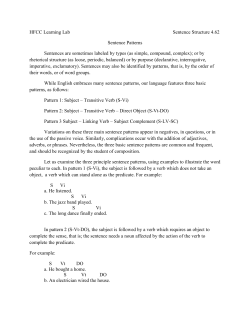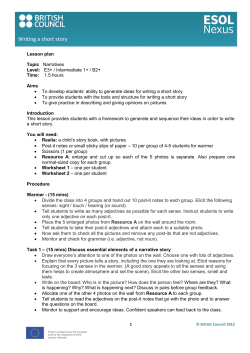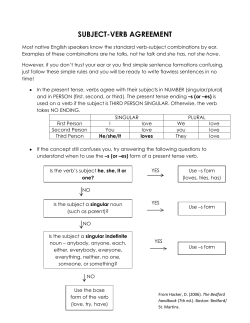
Document 268363
English Tasks: All-Words and Verb Lexical Sample
Martha Palmer, Christiane Fellbaum, Scott Cotton,
Lauren Delfs, and Hoa Trang Dang
University of Pennsylvania
{mpalmer,fellbaum,cotton,lcdelfs,htd }@linc.cis. upenn.edu
Abstract
We describe our experience in preparing the
lexicon and sense-tagged corpora used in the
English all-words and lexical sample tasks of
SENSEVAL-2.
1
Overview
The English lexical sample task is the result
of a coordinated effort between the University
of Pennsylvania, which provided training/test
data for the verbs, and Adam Kilgarriff at
Brighton, who provided the training/test data
for the nouns and adjectives (see Kilgarriff, this
issue). In addition, we provided the test data
for the English all-words task. The pre-release
version ofWordNet 1.7 from Princeton was used
as the sense inventory. Most of the revisions of
sense definitions relevant to the English tasks
were done prior to the bulk of the tagging.
The manual annotation for both the English
all-words and verb lexical sample tasks was done
by researchers and students in linguistics and
computational linguistics at the University of
Pennsylvania. All of the verbs in both the lexical sample and all-words tasks were annotated
using a graphical tagging interface that allowed
the annotators to tag instances by verb type and
view the sentences surrounding the instances.
Well over 1000 person hours went into the tagging tasks.
2
English All-Words Task
The test data for the English all-words task consisted of 5,000 words of running text from three
Wall Street Journal articles representing varied
domains from the Penn Treebank II. Annotators preparing the data were allowed to indiChristiane Fellbaum is at Princeton University, fellbaum@clarity.princeton.edu
21
System
SMUawAVe-Antwerp
LIA-Sinequa-AllWords
david-fa-UNED-AW-T
david-fa-UNED-AW-U
gchao2gchao3Ken-Litkowski-clr-aw (*)
Ken-Litkowski-clr-aw
gchaocm.guo-usm-english-tagger2
magnini2-irst-eng-all
cmguo-usm-english-tagger
c.guo-usm-english-tagger3
agirre2-ehu-dlist-all
juditadianam-system3ospdana
dianam-system2ospd
dianam-system1
woody-IIT2
woody-IIT3
woody-IITl
Precision
0.690
0.636
0.618
0.575
0.556
0.475
0.474
0.451
0.416
0.500
0.360
0.748
0.345
0.336
0.572
0.440
0.545
0.566
0.598
0.328
0.294
0.287
Recall
0.690
0.636
0.618
0.569
0.550
0.454
0.453
0.451
0.451
0.449
0.360
0.357
0.338
0.336
0.291
0.200
0.169
0.169
0.140
0.038
0.034
0.033
Table 1: System performance on English allwords task (fine-grained scores); (*) indicates
system results that were submitted after the
SENSEVAL-2 workshop and official deadline.
cate at most one multi-word construction for
each content word to be tagged, but could give
multiple senses for the construction. In some
cases, a multi-word construction was annotated
with senses associated with just the head word
of the phrase in addition to more specific senses
based on the entire phrase. The annotations
were done under a double-blind scheme by two
linguistics students, and were then adjudicated
and corrected by a different person.
Task participants were supplied with test
data only, in the standard all-words format for
SENSEVAL-2, as well as the original syntactic
and part-of-speech annotations from the 'freebank. Table 1 shows the system performance
on the task. Most of the systems tagged almost all the content words. This included not
only indicating the appropriate sense from the
WordNet 1.7 pre-release (as it stood at the time
of annotation), but also marking multi-word
constructions appropriate to the corresponding
sense tags. If given a perfect lemmatizer, a simple baseline strategy which does not attempt to
find the satellite words in multi-word constructions, but which simply tags each head word
with the first WordNet sense for the corresponding 'freebank part-of-speech tag, would result in
precision and recall of about 0.57.
3
English Lexical Sample Task
The data for the verb lexical sample task came
primarily from the Penn 'freebank II Wall
Street Journal corpus. However, where that
did not supply enough samples to approximate
75+ 15*n instances per verb, where n is the number of senses for the verb, we supplemented with
British National Corpus instances. We did not
find sentences for every sense of every word we
tagged. We also sometimes found sentences for
which none of the available senses were appropriate, and these were discarded. The instances
for each verb were partitioned into training/test
data using a ratio of 2:1.
We also grouped the nouns, adjectives and
verbs for the lexical sample task, attempting to
be explicit about the criteria for each grouping.
In particular, the criteria for grouping verbs
included differences in semantic classes of arguments, differences in the number and type
of arguments, whether an argument refers to
a created entity or a resultant state, whether
an event involves concrete or abstract entities
or constitutes a mental act, whether there is
a specialized subject domain, etc. All of the
verbs were grouped by two or more people, with
differences being reconciled. In some cases the
groupings of the verbs are identical to the existing WordNet groupings; in some cases they
are quite different. The nouns and adjectives
were grouped by the primary annotator in the
project; WordNet does not have comparable
groups for nouns and adjectives.
These groupings were used for coarse-grained
scoring, under the framework of SENSEVAL-1.
22
After the SENSEVAL-2 workshop, participanb
were invited to retrain their systems on th<
groups; only a handful of participants chose tc
do this, and in the end the results were uni·
formly only slightly better than training on thE
fine-grained senses with coarse-grained scoring.
Table 2 shows the system performancE
on just the verbs of the lexical samplE
task.
For comparison we ran several simple baseline algorithms that had been used in
SENSEVAL-1, including RANDOM, COMMONEST, LESK, LESK-DEFINITION, and LESKCORPUS (Kilgarriff and Rosenzweig, 2000}. In
contrast to SENSEVAL-1, in which none of the
competing systems performed significantly better than the highest baseline (LESK-CORPUS),
the best-performing systems this time performed well above the highest baseline.
Overall, the performance of the systems was
much lower than in SENSEVAL-1. Several factors may have contributed to this. In addition to the use of fine-grained WordNet senses
instead of the smaller Hector sense inventory
from SENSEVAL-1, most of the verbs included
in this task were chosen specifically because we
expected them to be difficult to tag. There was
also generally less training data made available
to the systems (ignoring outliers, there were on
average twice as many training samples for each
verb in SENSEVAL-1 as there were in SENSEVAL2). Table 3 shows the correspondence between
test data size (half of training data size), entropy, and system performance for each verb.
4
Annotating the Gold Standard
The annotators made every effort to match the
target word to a WordNet sense both syntactically and semantically, but sometimes this could
not be done. Given a conflict between syntax
and semantics, the annotators opted to match
semantics. For example, the word "train" has
an intransitive sense ("undergo training or instruction in preparation for a particular role,
function, or profession") as well as a related
(causative) transitive sense ("create by training
and teaching")_ Instances of "train" that were
interpreted as having a dropped object were
tagged with the transitive sense even though the
overt syntax did not match the sense definition.
Some sentences seemed to fit equally well
with two different senses, often because of am-
System
agirre3-ehu-dlist-best
magnini-irst-eng-sample
kunlpjhu-english-JHU-final (*)
SMUlsLIA-Sinequa-Lexsam ple
manning-cs224n
agirre3-ehu-dlist-all
talp-TALP
umcp-englishljhu-english-JHU-ENGLISH
montoyo-Uni v.-Alicante-System
jhu-english-JHU
tdpl-duluth3
tdpla-duluthC
tdpl-duluth5
tdpl-duluth4
baseline-lesk-corpus
tdpl-duluth2
tdpla-duluthA
tdpl-duluthl
tdpla-duluthB
baseline-commonest
david-fa!-UNED-LS-T
david-fal-UNED-LS-U
Haynes-IIT2
Haynes-IITl
Kenneth-Litkowski-clr-ls
Haynes-IIT2 (*)
Haynes-IITl (*)
baseline-lesk
michael-oakes.suss2
baseline-lesk-def
baseline-random
p
0.846
0.660
0.576
0.566
0.563
0.535
0.523
0.514
0.513
0.494
0.489
0.486
0.485
0.465
0.453
0.450
0.446
0.445
0.440
0.439
0.437
0.404
0.403
0.388
0.288
0.233
0.220
0.218
0.199
0.193
0.181
0.094
0.088
0.085
Verb
ferret
collaborate
wander
face
replace
use
begin
treat
live
match
train
drift
dress
serve
drive
leave
develop
see
wash
work
keep
call
play
find
carry
strike
pull
draw
turn
R
0.229
0.138
0.576
0.566
0.563
0.535
0.523
0.493
0.513
0.493
0.489
0.480
0.485
0.465
0.453
0.450
0.446
0.445
0.440
0.439
0.437
0.404
0.403
0.387
0.287
0.232
0.220
0.218
0.192
0.186
0.181
0.094
0.088
0.085
Size
1
30
50
93
45
76
280
44
67
42
63
32
59
51
42
66
69
69
12
60
67
66
66
68
66
54
60
41
67
Entropy
0.00
0.44
0.96
1.09
1.62
1.68
1.76
2.10
2.35
2.35
2.60
2.77
2.89
3.02
3.03
3.06
3.17
3.28
3.31
3.54
3.62
3.68
3.80
3.81
3.97
4.06
4.24
4.60
4.79
Fine
0.913
0.898
0.619
0.690
0.471
0.558
0.625
0.453
0.455
0.398
0.394
0.327
0.434
0.404
0.308
0.317
0.301
0.278
0.343
0.303
0.336
0.246
0.323
0.178
0.279
0.248
0.255
0.195
0.216
Coarse
0.913
0.898
0.786
0.785
0.860
0.682
0.625
0.543
0.476
0.620
0.492
0.354
0.679
0.445
0.528
0.428
0.456
0.317
0.535
0.442
0.353
0.457
0.345
0.285
0.332
0.331
0.414
0.264
0.327
Table 3: Test corpus size, entropy (base 2) of
tagged data, and average system recall for each
verb, using fine-grained and coarse-grained scarmg.
Table 2: System precision (P) and recall (R) for
English verb lexical sample task (fine-grained
scores); (*) indicates system results that were
submitted after the SENSEVAL-2 workshop and
official deadline.
biguous context; others did not fit well under
any sense. One of the solutions employed in
these cases was the assignment of multiple sense
tags. The taggers would choose two senses (on
rare occasions, even three) that they felt made
an approximation of the correct sense when used
in combination. Sometimes this strategy was
also used in arbitration, when it was decided
that neither tagger's tag was better than the
other. The taggers tried to use this strategy
sparingly and chose single tags whenever possible.
Often, a particular verb yielded multiple in-
23
stances of what was clearly a salient sense, but
one not found in WordNet. One of the results
was that sentences that should have received a
clear sense tag ended up with something rather
ad hoc, and often inconsistent. One of the
most notorious examples was "call," which had
no sense that fit sentences like "The restaurant is called Marrakesh." WordNet contains
some senses related to this one. One sense
refers to the bestowing of a name; another to
informal designations; another to greetings and
vocatives. But there is no sense in WordNet
for simply stating something's name without
additional connotations, and the gap possibly
caused some inconsistencies in the annotation.
All these senses belonged to the same group,
and if the annotators had been allowed to tag
with the more general group sense, there may
have been less inconsistency.
It has been well-established that sensetagging is a very difficult task (Kilgarriff, 1997;
Hanks, 2000), even for experienced human taggers. If the sense inventory has gaps or redundancies, or if some of the sense glosses have
ambiguous wordings, choosing the correct sense
can be all but impossible. Even if the annotator
is working with a very good entry, unforeseen
instances of the word always arise.
The degree of polysemy does not affect the
relative difficulty of tagging, at least not in the
way it is often thought. Very polysemous words,
such as "drive," are not necessarily harder to
tag than less polysemous words like "replace."
The difficulty of tagging depends much more on
other aspects of the entry and of the word itself.
Often very polysemous words are quite difficult
to tag, because they are more likely to be underspecified or occur in novel uses; however, "replace," with four senses, proved a difficult verb
to tag, while "play," with thirty-five senses, was
relatively straightforward.
In many ways, the grouped senses are very
helpful for the sense-tagger. Grouping similar
senses allows the sense-tagger to study side-byside the senses that are perhaps most likely to be
confused, which is helpful when the differences
between the senses are very subtle. However, it
would be a poor idea to attempt to tag a corpus
using only the groups, and not the finer sense
distinctions, because often some of the senses
included in a group will have some properties
that the others do not; it is always better to
make the finest distinction possible and not just
assign the same tag to everything that seems
close.
Inter-annotator agreement figures for the human taggers are quite low. However, in some
respects they are not quite as low as they seem.
Some of the apparent discrepancies were sim-,
ply the result of a technical error: the annotator accidentally picked the wrong tag, perhaps
choosing one of its neighbors. Other differences
resulted from the sense inventories themselves.
Sometimes the taggers interpreted the wording
of a given sense definition in different ways,
which caused them to choose different tags, but
does not entail that they had interpreted the
instances differently; in fact, discussion of such
cases usually revealed that the taggers had in24
terpreted the instances themselves in the sam
way. Additional apparent discrepancies resulte<
from the various strategies for dealing with case
in which there was no single proper sense i1
WordNet. This was the case when an instanc(
in the corpus was underspecified so as to al
low multiple appropriate interpretations. Thi:
resulted in (a) multiple tags by one or bot}
taggers, and (b) each tagger making a differ·
ent choice. Here, again, the taggers often ha(
the same interpretation of the instance itself
but because the sense inventory was insufficieni
for their needs, they were forced to find differen1
strategies. Sometimes, in fact, one tagger would
double-tag a particular instance while the second tagger chose a single sense that matched
one of the two selected by the first annotator.
This is considered a discrepancy for statistical
purposes, but clearly reflects siip.ilar interpretations on the part of the annotators.
In the most recent evaluation, with two new
annotators tagging against the Gold Standard,
the best fine-grained agreement figures for verbs
were in the 70's, similar to Semcor figures. However, when we used the groupings to do a more
coarse-grained evaluation, and counted a match
between a single tag and a member of a double
tag as correct, the human annotator agreement
figures rose to 90%.
5
Acknowledgments
Support for this work was provided by the
National Science Foundation (grants NSF9800658 and NSF-9910603), DARPA (grant
535626}, and the CIA (contract number
2000*S053100*000). We would also like to
thank Joseph Rosenzweig for building the annotation tools, and Susanne Wolff for contribution
to the manual annotation.
References
Patrick Hanks. 2000. Do word meanings exist? Computers and the Humanities, 34(1-2},
April. Special Issue on SENSEVAL.
A. Kilgarriff and J. Rosenzweig. 2000. Framework and results for English SENSEVAL.
Computers and the Humanities, 34(1-2),
April. Special Issue on SENSEVAL.
Adam Kilgarriff. 1997. I don't believe in
word senses. Computers and the Humanities,
31(2).
© Copyright 2025















